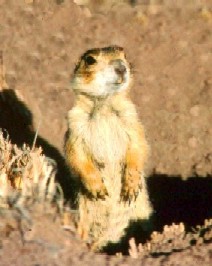Prairie DogfightAdam Rankin -- Albuquerque Journal -- Feb 24, 2004 -- New Mexico |
|
In the city that requires
developers to humanely relocate entire
colonies of prairie dogs, the Santa Fe-based conservation group Forest
Guardians announced Monday a petition to get federal protection for one
variety of the beguiling creature. The Gunnison's
prairie dog — slightly smaller than
the four other North American species and with white-tipped tail— has
suffered extensive reduction in its range across the Southwest after a
century of poisoning, shooting, habitat destruction and other
human-derived adversities, according to its proponents. The Gunnison's
prairie dog — slightly smaller than
the four other North American species and with white-tipped tail— has
suffered extensive reduction in its range across the Southwest after a
century of poisoning, shooting, habitat destruction and other
human-derived adversities, according to its proponents.They say that decline has been detrimental to a host of other plants and animals, such as the burrowing owl, that rely on the prairie dog to provide critical habitat. A few years ago, Santa Fe was the site of squabble over a tract of land proposed for development where a colony of the prairie dogs across the street from an elementary school were threatened. The City Council solved that problem in 2001, unanimously approving a law requiring some developers to relocate the colonies before building, or pay $500-a-day penalties. The Gunnison's prairie dog now occupies about 10 percent of its historic 40 million to 50 million acre range, which includes parts of New Mexico, Arizona, Utah and Colorado, said Forest Guardian biologist Nicole Rosmarino. She said the prairie dog's range in New Mexico has been reduced by about 98 percent to 75,000 acres. She and another biologist co-authored the petition to consider Gunnison's prairie dogs for protection under the Endangered Species Act. A coalition of more than 70 groups and individuals, including realtors, developers, conservation groups, scientists and at least one New Mexican rancher has signed the petition. More than 30 people turned out at a press conference announcing the petition. |
Northern Arizona
University biologist Con Slobodchikoff
told the group about his research that shows prairie dogs
possess a complex communication system, able to distinguish between
predators, humans and dogs. He said they can even relate how fast an
animal is approaching and what color clothes a person is wearing. ["The world's expert on prairie dog
communication", Dr. Con Slobodchikoff, was raised in
San
Francisco of Russian-born parents. His wife, Anne
Slobodchikoff, is NAU's
Russian
and French language professor, and advisor for the NAU Russian Culture
Club. This article led to another in December,
and an Editorial in The Arizona Republic. Also see "Prairie
Dog Communication", a
collection of his articles.] ["The world's expert on prairie dog
communication", Dr. Con Slobodchikoff, was raised in
San
Francisco of Russian-born parents. His wife, Anne
Slobodchikoff, is NAU's
Russian
and French language professor, and advisor for the NAU Russian Culture
Club. This article led to another in December,
and an Editorial in The Arizona Republic. Also see "Prairie
Dog Communication", a
collection of his articles.]The U.S. Fish and Wildlife Service, the federal agency that oversees the Endangered Species Act, has 90 days to decide whether the petition warrants further review. Rosmarino predicted a long struggle, which will likely require litigation, to gain federal protection for the rodent, citing a federal administration "incredibly hostile" to endangered species. But others are likely to voice opposition, as well. "Listing species doesn't do anybody any good," said Caren Cowan, executive director of the New Mexico Cattle Grower's Association. She said her group would likely submit comments on any plan to offer Gunnison's prairie dogs federal protection. She said such protection brings onerous land-use restrictions that can conflict with cattle growers and other private landowners, which can be especially damaging to rural economies. "The Forest Guardians are, in our view, trying to control land use via the Endangered Species Act, and we find that to be wrong," she said. The cattle growers' association has been part of a working group for the past two years evaluating the status of another New Mexico rodent, the black-tailed prairie dog, which the Fish and Wildlife Service decided warrants listing but precluded from protection due to higher priorities. Cowan said she would prefer to work with the state on prairie dog management plans to avoid federal protection. Chuck Hayes, who works on endangered mammal species for the state Game and Fish Department, said New Mexico is part of a multi-state conservation team set up to assess the status of the Gunnison's and the white-tailed prairie dog species. "It is a good thing to preclude the need to list," he said. The state is working to implement a conservation plan for the black-tailed prairie dog, he said. That plan is still under review for listing by the government. |